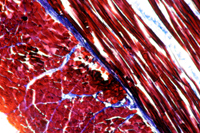Capillary motor regulation
 Capillaries are the smallest blood vessels, and run throughout muscle fibres, allowing oxygen to diffuse from the blood into the muscles. The demand for oxygen varies, increasing when muscles are active, and decreasing during rest.
Capillaries are the smallest blood vessels, and run throughout muscle fibres, allowing oxygen to diffuse from the blood into the muscles. The demand for oxygen varies, increasing when muscles are active, and decreasing during rest.
It was believed that when the muscles were active, arteries contracted, pushing the blood through the capillaries more rapidly, so that more oxygen would reach the muscles. Krogh’s calculations showed that any resulting increase in oxygen would be too small for the demands of the active muscle. He examined the muscles in frogs and small mammals, finding that open capillaries could be seen clearly using a microscope, and that more capillaries were open in active muscles.
To find out many capillaries were open at a given time, he suspended black ink in the blood of living animals by IV infusion. When the animal was killed, the ink stained those capillaries which had been open at during the transfusion. Through these simple experiments Krogh was able to clearly show the differences in the capillaries between active and resting muscle. Not only were more capillaries open in active muscle, but their diameter was greater, allowing greater blood flow and a greater surface area for diffusion to take place.
A few of August Krogh’s remarkable images illustrate his Nobel Lecture at the Nobel Prizes website.
The 1920 Nobel Prize in medicine pages
Last edited: 27 August 2014 05:48
